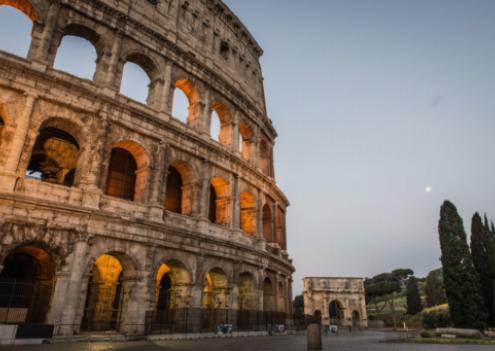Perched majestically along the banks of the Tiber River in the heart of Rome stands Castel Sant'Angelo, a monumental structure that has stood the test of time for over two millennia. This iconic landmark has undergone many transformations throughout its rich history, serving various purposes from a mausoleum for an emperor to a fortress and eventually a museum. With its unique blend of Roman and Renaissance architecture, Castel Sant'Angelo stands as a testament to the enduring legacy of ancient Rome and continues to captivate visitors with its timeless beauty and fascinating tales of angels and emperors.

The Architecture of Castel Sant'Angelo: Blending Roman and Renaissance Styles
Castel Sant'Angelo, also known as the Mausoleum of Hadrian, stands as an iconic symbol of Rome, blending both Roman and Renaissance architectural styles. The structure itself is a testament to the rich history and cultural influences that have shaped the city over the centuries.
Built by Emperor Hadrian in the 2nd century AD, Castel Sant'Angelo features a distinctive cylindrical shape that is characteristic of Roman architecture. The sturdy stone walls and fortified towers reflect the military and defensive purposes for which the building was originally intended.
However, it was during the Renaissance period that Castel Sant'Angelo underwent significant changes and additions. In the 15th century, Pope Nicholas III commissioned the construction of a grand corridor connecting the castle to the Vatican, allowing for safe passage for the Pope in times of danger. This corridor, known as the Passetto di Borgo, features elegant arches and decorative elements typical of Renaissance architecture.
The exterior of Castel Sant'Angelo also showcases a mix of Roman and Renaissance styles, with ornate sculptures and reliefs adorning the façade. The imposing statue of the Archangel Michael at the top of the castle's ramparts is a striking example of the fusion of religious and classical motifs.
Overall, the architecture of Castel Sant'Angelo serves as a testament to the enduring influence of both Roman and Renaissance aesthetics on the city of Rome. Its harmonious blend of styles reflects the layers of history and culture that make Rome such a fascinating destination for visitors from around the world.
The Functionality of Castel Sant'Angelo: From Mausoleum to Museum
Castel Sant'Angelo, originally known as the Mausoleum of Hadrian, was built in 123 AD as a tomb for the Roman Emperor Hadrian and his family. Over the centuries, the building has served various functions, including as a fortress, a prison, and a papal residence. In the 20th century, it was transformed into a museum, showcasing its rich history and housing various art and artifacts. This transformation has allowed visitors to explore the diverse roles that Castel Sant'Angelo has played throughout its long history, from a grandiose burial site to a cultural landmark steeped in myth and legend.
The Art and Artifacts of Castel Sant'Angelo: A Treasure Trove of History
From intricate frescoes and sculptures to ancient weapons and armor, the castle is home to a diverse collection that spans centuries.
One of the most notable features of the castle is the Papal apartments, which are adorned with stunning frescoes that depict scenes of both religious and secular significance. These intricate paintings provide a window into the world of Renaissance art and offer insights into the lives of the popes who once resided within these walls.
In addition to the frescoes, visitors to Castel Sant'Angelo can also explore the museum's collection of artifacts, which includes a wide array of items ranging from ancient Roman coins to medieval weapons. These artifacts offer a tangible connection to the past and illustrate the rich history of the castle as both a mausoleum and fortress.
Among the most impressive pieces in the collection are the various sculptures that adorn the castle's interior and exterior. These sculptures range from classical depictions of emperors and gods to intricate statues of angels, each with its own unique story to tell. These works of art serve as a testament to the skill and creativity of the artists who crafted them, as well as to the enduring legacy of Castel Sant'Angelo itself.
Overall, the art and artifacts of Castel Sant'Angelo provide a captivating look into the history and culture of this iconic structure. From ancient Roman relics to stunning Renaissance masterpieces, the treasures housed within these walls offer a tangible connection to the past and serve as a reminder of the enduring legacy of this historic site.
The Legends and Myths Surrounding Castel Sant'Angelo: Stories of Angels and Emperors
Castel Sant'Angelo, also known as the Mausoleum of Hadrian, is shrouded in legends and myths that add to its allure and mystique. One popular legend surrounding the castle is that of the Angel of the Castle, a beautiful angel that was seen atop the castle during the plague of 590 AD. According to legend, the angel appeared and sheathed his sword, signaling the end of the plague and saving the city of Rome from further devastation.
Another myth associated with Castel Sant'Angelo is that of the ghost of Emperor Hadrian himself. It is said that the ghost of the emperor still roams the corridors of the castle, guarding his tomb and haunting those who dare to disturb his resting place.
In addition to these legends, Castel Sant'Angelo is also steeped in historical myths surrounding its construction and purpose. Some believe that the castle was built on the site where the archangel Michael appeared to Pope Gregory the Great, leading to the castle's transformation into a fortress and papal residence.
Whether rooted in history or folklore, the legends and myths surrounding Castel Sant'Angelo only serve to enhance its rich history and make it a must-see destination for visitors to Rome.
